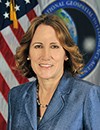DARPA’s Timothy Grayson, Lockheed Martin’s Rita Flaherty, and Intel’s Jonathan Doylend among top-line plenary speakers at 2021 SPIE DCS Digital Forum

From 12-16 April, SPIE Defense + Commercial Sensing Digital Forum will continue its more-than 45-year-run as the leading symposium on imaging, sensing, and photonic technologies used for defense and security applications, as well as showcasing emerging innovations for health care, industry, and environmental applications.
During this year's virtual event, world-class plenary speakers are scheduled to cover key topics such as warfare and sensing; autonomous vehicles and AI; and silicon photonics for lidar. Timothy Grayson is the director of the Strategic Technology Office (STO) at the Defense Advanced Research Projects Agency (DARPA), where he heads the development of breakthrough technologies to enable warfighters to field, operate, and adapt distributed, joint, multi-domain combat capabilities at continuous speed.
Timothy Grayson is the director of the Strategic Technology Office (STO) at the Defense Advanced Research Projects Agency (DARPA), where he heads the development of breakthrough technologies to enable warfighters to field, operate, and adapt distributed, joint, multi-domain combat capabilities at continuous speed.
Grayson will open the symposium in a plenary session on Monday, 12 April, with "Mosaic Warfare and implications for novel sensing." His presentation will discuss how DARPA is developing Mosaic Warfare - a strategy where individual warfighting platforms are put together to make a larger package. The concept is an effort to move from expensive, complex, multi-function monolithic sensors to highly distributed, hyper-specialized sensors with each individual sensor addressing only a small part of an overall function. This specialization will allow for the deployment of sensors in greater numbers on smaller, cheaper platforms. Grayson's presentation will also address how DARPA is implementing Mosaic, the implications for sensing, and potential dual-use applications in the commercial sector.
 Donald A. Reago, Jr., acting director of the Command, Control, Communications, Computer, and Cyber, Intelligence, Surveillance, and Reconnaissance (C5ISR) Center, under the Combat Capabilities Development Command (CCDC), will also give a talk on Tuesday entitled "Sensing for warfare in the digital information age."
Donald A. Reago, Jr., acting director of the Command, Control, Communications, Computer, and Cyber, Intelligence, Surveillance, and Reconnaissance (C5ISR) Center, under the Combat Capabilities Development Command (CCDC), will also give a talk on Tuesday entitled "Sensing for warfare in the digital information age." Rita Flaherty is vice president of Strategy and Business Development at Lockheed Martin Missiles and Fire Control. In her role, she focuses on expanding existing business opportunities, customer relationship management, and new product developments for domestic and international customers, leadings a team of experienced strategy and business development professionals with significant US Army, Navy, Air Force, and Marine Corps personal and professional ties.
Rita Flaherty is vice president of Strategy and Business Development at Lockheed Martin Missiles and Fire Control. In her role, she focuses on expanding existing business opportunities, customer relationship management, and new product developments for domestic and international customers, leadings a team of experienced strategy and business development professionals with significant US Army, Navy, Air Force, and Marine Corps personal and professional ties.
At the symposium-wide plenary session on Tuesday, 13 April, Flaherty will discuss "Strategically integrating small business in the face of unprecedented challenges." Her presentation will address t ways in which pandemic- and budget-related impacts to the global supply chain have driven a change in how we approach partnerships with small businesses and the people-power they provide. Her talk will also focus on the importance of cultivating productive and mutually beneficial relationships with suppliers while simultaneously driving economic development in local communities. In addition, she will cover the challenge of virtual recruiting, encouraging diversity in the workforce while attracting local talent and the avenues for small business to connect with Lockheed Martin.
 Autonomy and AI have made tremendous progress in recent years to the point where operational applications of these technologies can provide decisive advantages. At Tuesday's plenary session, Jean-Charles Ledé, Technical Advisor at the Air Force Research Laboratory (AFRL), will discuss the approach recommended to rapidly field autonomy and AI capabilities at scale, including the development of a common platform; addressing trust issues; and applying agile methodology. In his presentation, "Operationalizing Autonomy and AI for the Air Force," Ledé, who oversees the AFRL Autonomy and AI portfolio, will offer examples in sensor exploitation, and demonstrate the operational value of the current generation of AI. As this generation has limitations, Ledé will also cover aspects of future research required to expand the safe, ethical, and effective use of AI technologies.
Autonomy and AI have made tremendous progress in recent years to the point where operational applications of these technologies can provide decisive advantages. At Tuesday's plenary session, Jean-Charles Ledé, Technical Advisor at the Air Force Research Laboratory (AFRL), will discuss the approach recommended to rapidly field autonomy and AI capabilities at scale, including the development of a common platform; addressing trust issues; and applying agile methodology. In his presentation, "Operationalizing Autonomy and AI for the Air Force," Ledé, who oversees the AFRL Autonomy and AI portfolio, will offer examples in sensor exploitation, and demonstrate the operational value of the current generation of AI. As this generation has limitations, Ledé will also cover aspects of future research required to expand the safe, ethical, and effective use of AI technologies.
 The Advanced Sensing and Imaging Track will feature Quanzeng Wang of the US Food and Drug Administration (FDA) on Wednesday, 14 April. Wang, the FDA Primary Liaison Representative to several international standard working groups, will discuss "Infrared thermographs for fever screening: international standards, FDA guidance, and large-scale clinical study." Infrared thermographs (IRTs) have been used for fever screening during infectious disease epidemics, but their performance is inconsistent in literature due to wide quality/implementation variations.
The Advanced Sensing and Imaging Track will feature Quanzeng Wang of the US Food and Drug Administration (FDA) on Wednesday, 14 April. Wang, the FDA Primary Liaison Representative to several international standard working groups, will discuss "Infrared thermographs for fever screening: international standards, FDA guidance, and large-scale clinical study." Infrared thermographs (IRTs) have been used for fever screening during infectious disease epidemics, but their performance is inconsistent in literature due to wide quality/implementation variations.
Starting with an overview of standards and FDA guidance for IRT performance evaluation, implementation, and regulation policies, Wang will present results from a large-scale clinical study of fever-screening IRTs, as well as discussing the impact of consensus guidelines and facial measurement location on performance. This study found that while high-quality IRTs implemented according to international standards can help to accurately measure temperature, current standards can be improved to further enhance IRT performance.
 Also on Wednesday, the Next Generation Sensor Systems and Applications Track will feature Stuart Young, program manager in the Tactical Technology Office at DARPA discussing "Robot autonomy in complex environments (ERP)."According to Young, the self-driving car industry has made great advances, but primarily for well-structured and highly predictable environments. In complex military settings, robotic vehicles have not demonstrated operationally relevant speed and aren't autonomously reliable.
Also on Wednesday, the Next Generation Sensor Systems and Applications Track will feature Stuart Young, program manager in the Tactical Technology Office at DARPA discussing "Robot autonomy in complex environments (ERP)."According to Young, the self-driving car industry has made great advances, but primarily for well-structured and highly predictable environments. In complex military settings, robotic vehicles have not demonstrated operationally relevant speed and aren't autonomously reliable.
Young will discuss how DARPA's Robotic Autonomy in Complex Environments with Resiliency (RACER) program aims to make sure algorithms aren't a limiting part of the system and that autonomous combat vehicles can meet or exceed soldier-driving abilities. RACER will offer game-changing unmanned ground vehicle UGV mobility, focused on speed and resiliency, using a combination of simulation and advanced platforms. Goals for the RACER program include not only autonomy algorithms, but also the creation of simulation-based approaches and environments that will support rapid advancement of self-driving capabilities for future UGVs.
 On Thursday, 15 April, the Materials and Devices Track will feature Jonathan Doylend, technical lead for silicon photonics lidar development at Intel Corporation discussing "Silicon photonics for lidar."
On Thursday, 15 April, the Materials and Devices Track will feature Jonathan Doylend, technical lead for silicon photonics lidar development at Intel Corporation discussing "Silicon photonics for lidar."
Doylend notes that lidar is emerging as a necessity for fully automated self-driving automotive applications. In order to sample the far field with sufficient resolution for this application, the system must incorporate several optical elements, which leads to challenges in manufacturability and size. Due to the density of optical components required, lidar is well suited for photonic integration in order to achieve miniaturization and scalable manufacturability. Doylend will give an overview of lidar, the components required for a chip-scale solution, and the progress of silicon photonics with lidar.
 Also on Thursday, 15 April, as part of the Imaging and Analytics Track, Cynthia Daniell, director of the Research Directorate for the National Geospatial-Intelligence Agency (NGA) will discuss "Renaissance at NGA." Daniell, who joined NGA in 2018, brings more than 30 years of experience in the Department of Defense (DoD) community from both government service and private industry. This prior experience has focused largely on the technology development of image processing, computer vision, AI, and the integration of these technologies into systems.
Also on Thursday, 15 April, as part of the Imaging and Analytics Track, Cynthia Daniell, director of the Research Directorate for the National Geospatial-Intelligence Agency (NGA) will discuss "Renaissance at NGA." Daniell, who joined NGA in 2018, brings more than 30 years of experience in the Department of Defense (DoD) community from both government service and private industry. This prior experience has focused largely on the technology development of image processing, computer vision, AI, and the integration of these technologies into systems.
Read more about what's happening at the 2021 SPIE Defense + Commercial Sensing Digital Forum.



